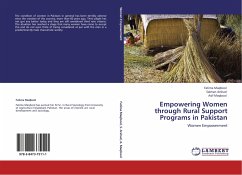
Support Systems of Widows in Tirumala - Tirupati
Support System - A tool for Women Development
Versandkostenfrei!
Versandfertig in 6-10 Tagen
52,99 €
inkl. MwSt.

PAYBACK Punkte
26 °P sammeln!
In India, the widows as against the widowers thus form a major group. In 1951, the widow population was more than two times that of widower population; in 1961 and 1971, it was less than thrice that of widower population; in 1981 it was more than three times that of widower population; and in 1991 it was more than four times that of widower population. In 2001 and 2011 it was more than six times that of widower population. The proportion of young widows has decreased when compared to the previous during the decades 2001-2011. It is a symbol of social change. Employee widows lead a better life ...
In India, the widows as against the widowers thus form a major group. In 1951, the widow population was more than two times that of widower population; in 1961 and 1971, it was less than thrice that of widower population; in 1981 it was more than three times that of widower population; and in 1991 it was more than four times that of widower population. In 2001 and 2011 it was more than six times that of widower population. The proportion of young widows has decreased when compared to the previous during the decades 2001-2011. It is a symbol of social change. Employee widows lead a better life when compared to the unemployee widow. A support system is a weapon for widows. Widows needed upliftment in all wise of supports like, economic, social, service and emotional should starts from family that is primary institution and it should be extended in all secondary institutions in society.












